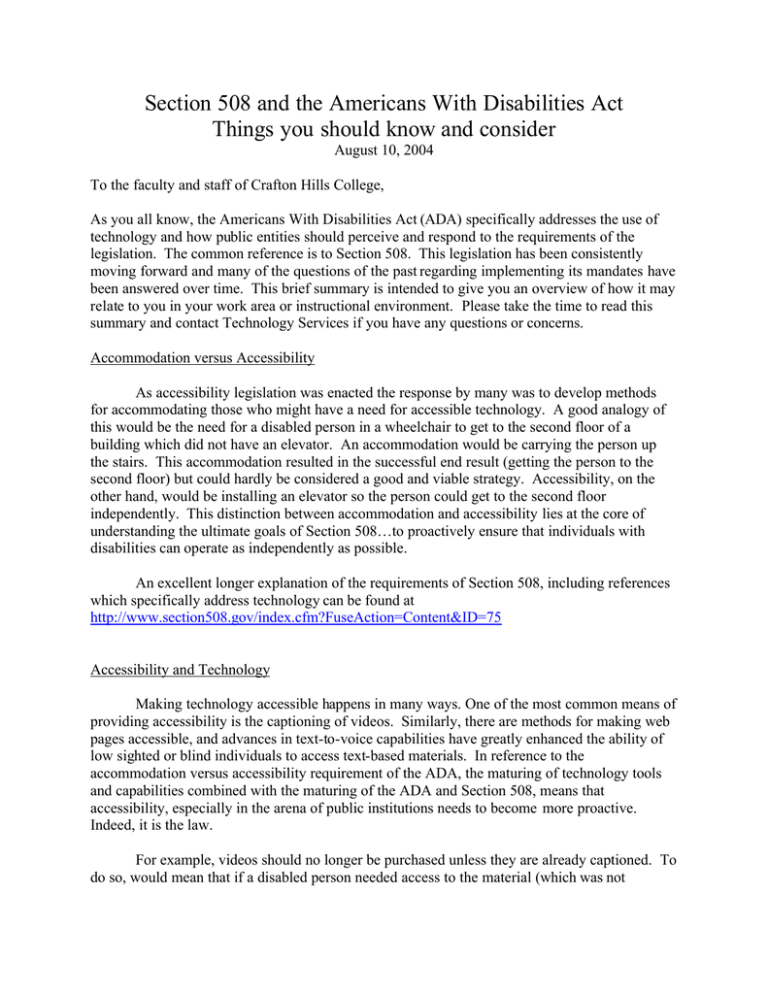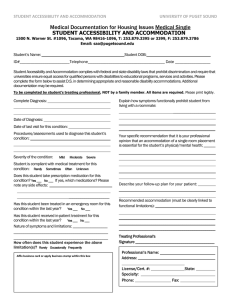Section 508 and the Americans With Disabilities Act
advertisement

Section 508 and the Americans With Disabilities Act Things you should know and consider August 10, 2004 To the faculty and staff of Crafton Hills College, As you all know, the Americans With Disabilities Act (ADA) specifically addresses the use of technology and how public entities should perceive and respond to the requirements of the legislation. The common reference is to Section 508. This legislation has been consistently moving forward and many of the questions of the past regarding implementing its mandates have been answered over time. This brief summary is intended to give you an overview of how it may relate to you in your work area or instructional environment. Please take the time to read this summary and contact Technology Services if you have any questions or concerns. Accommodation versus Accessibility As accessibility legislation was enacted the response by many was to develop methods for accommodating those who might have a need for accessible technology. A good analogy of this would be the need for a disabled person in a wheelchair to get to the second floor of a building which did not have an elevator. An accommodation would be carrying the person up the stairs. This accommodation resulted in the successful end result (getting the person to the second floor) but could hardly be considered a good and viable strategy. Accessibility, on the other hand, would be installing an elevator so the person could get to the second floor independently. This distinction between accommodation and accessibility lies at the core of understanding the ultimate goals of Section 508…to proactively ensure that individuals with disabilities can operate as independently as possible. An excellent longer explanation of the requirements of Section 508, including references which specifically address technology can be found at http://www.section508.gov/index.cfm?FuseAction=Content&ID=75 Accessibility and Technology Making technology accessible happens in many ways. One of the most common means of providing accessibility is the captioning of videos. Similarly, there are methods for making web pages accessible, and advances in text-to-voice capabilities have greatly enhanced the ability of low sighted or blind individuals to access text-based materials. In reference to the accommodation versus accessibility requirement of the ADA, the maturing of technology tools and capabilities combined with the maturing of the ADA and Section 508, means that accessibility, especially in the arena of public institutions needs to become more proactive. Indeed, it is the law. For example, videos should no longer be purchased unless they are already captioned. To do so, would mean that if a disabled person needed access to the material (which was not captioned) an accommodation of some sort would need to be made. That…is not a proactive move towards accessibility. Legislation now dictates that any NEW videos MUST be captioned prior to the first use of this video in an instructional (or other) setting, whether or not there is an immediate need for that accessible feature. Alternate and Accessible Materials Obviously, addressing accessibility requires that organizations and individuals approach the development of materials or the dissemination of resources or services differently than in the past. In the realm of instruction, it requires that instructors plan ahead to ensure that the materials they use are, indeed, accessible. This could mean researching texts or other materials a bit more carefully to ensure that included supplemental materials are accessible (CD’s, electronic text that can be placed on a computer, etc.). Further, making the effort to inform DSP&S regarding the materials you are using in your courses, especially electronic text or proprietary software programs will enable that department to better help both you and your students achieve those goals you’ve set out to accomplish in any individual class or program. In the end, it is the decisions made by the instructors which will determine whether their courses are accessible or not. Part of the role of CHC Technology Services and the DSP&S departments is to assist instructors in the development of alternative/accessible materials to ensure compliance with the ADA. Resources As just mentioned Crafton Hills College has resources available to help instructors and departments with addressing and implementing the requirements of the ADA and Section 508. In addition, the following list of web sites should be helpful for those who are feeling the need to better understand the scope of the legislation. Also, please do not hesitate to call Technology Services (x3550) for help, explanations, or other info regarding the ADA and how it might be addressed in individual instances. Obviously, this legislation cannot be addressed in this short document but, hopefully, it has helped you better understand how it applies to you and your role at CHC. Useful web sites: High Tech Center Training Unit (Foothill College) http://www.htctu.net/index.htm WWW Section 508. Gov http://www.section508.gov/index.cfm Web Content Accessibility Guidelines http://www.w3.org/TR/WAI-WEBCONTENT Ted Phillips Coordinator, Technology Services Instructional Designer/Assistive Technology Specialist

